
The Nantahala offers anglers choices of wild, stocked, hatchery-supported, delayed-harvest, freestone and tailrace trout.
As the river’s swift water roars through the rugged topography of western North Carolina, it cuts an impressive gorge through the Earth’s crust. Since many areas of this gorge never are touched by sunlight except during the middle of the day, the Cherokee people named this place, Nantahala, roughly translated as “Land of the Noonday Sun.”
The “Nanty,” as locals call it, is one of North Carolina’s most-celebrated trout steams. It has been listed in Trout Unlimited’s popular book, “America’s 100 Best Trout Streams.” That’s because the stream’s fishing options are diverse, including wild fish, stocked fish, delayed-harvest, hatchery-supported, freestone and a tailrace.
The Nantahala rises in the high country of Macon County and supports wild trout at its headwaters and throughout its upper reaches and tributaries. This upper section is typical of most freestone mountain streams in North Carolina, where the trout are on the small side but wild — and beautiful beyond words.
Unfortunately, much of the best water upstream of Nantahala Lake is on private property, including the large section owned and operated by the Rainbow Springs Fishing Club.
After the river flows into man-made Nantahala Lake (also known as Aquone Lake), it changes dramatically in character. Since water from the lake is diverted through a 7-mile-long pipeline to a hydroelectric powerhouse at Beechertown, the river essentially starts over from scratch, collecting all of its water from small tributaries and springs near that area.
From the base of the dam to the confluence with White Oak Creek, the N.C. Wildlife Resources Commission manages what remains of the river as wild-trout water. The trout are small, spunky, and not selective feeders.
Downstream of its confluence with White Oak Creek — which marks the upper boundary of the delayed-harvest trout water — the Nanty becomes a formidable river once again.
This piece of water is the most-popular fishing section of the entire river and one of the most heavily-fished, delayed-harvest streams in the state. The current is easy to wade, and generous angler accesses occur at the road, which parallels the river throughout its entire distance of delayed-harvest water.
“Of all the delayed-harvest streams in the area, the Nantahala section is probably the most popular,” said Powell Wheeler, the commission’s District 9 fisheries biologist. “It’s fished heavily by out-of-state anglers as well as North Carolinians.”
The Nantahala was the first delayed-harvest stream established when the commission embarked on its trout-management experiment. The gamble paid off in spades, as its success subsequently spawned 14 more delayed-harvest streams. This popularity is created by delayed-harvest regulations offering something for all types of anglers.
“Delayed-harvest has been an incredibly successful program,” Wheeler said. “It combines the catch-and-release fishing many fly anglers crave with the opportunity to harvest fish as well, which many other types of anglers enjoy.”
The delayed-harvest season begins in October and continues through the winter and spring into June. During this time, anglers only may use single-hook, artificial flies and lures, and all fish must be returned to the stream unharmed.
In early June, general hatchery-supported regulations take effect until October, when the delayed-harvest season begins once again.
According to Wheeler, trout are generously stocked throughout the delayed-harvest section with a mix of brook, brown, and rainbows.
“The 4-mile section of delayed-harvest water gets stocked with 18,500 fish per year,” Wheeler said. “These fish are stocked during October, November, March, April and May.”
Roger Lowe of Lowe Guide Service in Waynesville said he sees good insect hatches at the delayed-harvest section of the Nantahala each spring.
“This section of the Nanty fishes good in the spring and offers great Caddis, Quill Gordon, Hendricksons, and March Brown hatches each year,” Lowe said. “This is some great pocket water which is perfect for dry-fly-and-dropper combinations.”
Dry flies, which imitate insects, will catch fish regularly in the spring, as well as Pheasant Tail nymphs as dry-fly droppers or fished below a strike indicator.
A black or olive Woolly Bugger with some crystal flash, stripped through deeper pools, always catches a fish or two, particularly after a fresh stocking or during an early-morning outing.
Although the current stream bed appears benign enough, wading can be tricky. A wading staff and felt-soled wading boots are recommended.
“The biggest challenge at the upper Nanty delayed-harvest section is to be careful when wading,” said Lowe. “There are lots of rocky areas in the stream, even though access from the road is relatively easy.”
Because the delayed-harvest section is smaller and tighter than other parts of the river, Lowe recommends a fly rod in 7½- to 8-foot lengths to help avoid getting into the trees.
“There are a lot of overhanging trees that makes casting tricky,” he said.
Once the river reaches the hydroelectric powerhouse at Beechertown, the Nanty is transformed once again.
This section of the river is the tailrace, where water from Lake Nantahala that is diverted via the pipeline re-enters the river channel. The Nantahala then flows through the narrow, twisting, 8-mile gorge before finally emptying into Fontana Lake.
Through the gorge, the river drops an average of 36 feet per mile. Long, deep pools of emerald-green water are punctuated by riffles, rapids and dangerous whitewater when the generators are running.
Trout are stocked through the gorge. and the commission manages the river as hatchery-supported trout water.
“The 8-mile section of the Nantahala River from the hydro-power discharge canal to Lake Fontana is stocked with 5,000 trout per year,” Wheeler said. “This hatchery-supported section is usually stocked from March through July.
During 2008, because of fears about an ongoing drought, the commission stocked all 5,000 fish between March and June. There was no change in overall numbers of stocked trout, but most of them were stocked earlier.
During hatches on the lower Nantahala, fish will rise to the bugs as close as a foot or two from commercial rafts and kayakers. The trout, used to the steady traffic, continue to feed in the midst of numerous float trips.
However, fishing the river’s tailrace during high water is a tricky and dangerous proposition. Wading isn’t recommended, but it can be done only if a fisherman is a strong, experienced wader.
“If you choose to wade fish during generation, use extreme caution due to high water levels,” Lowe said.
Fishing from the bank or during low water is easier and safer.
“The tailrace section in the gorge can be challenging for wade fishing because of daily water generation for the rafters,” Lowe said.
“Depending on release schedules, good wade fishing is usually possible during the early morning before release of water or after the water is turned off in the late evenings.”
When wading the river during low water, anglers should be prepared for the possibility that levels may rise quickly and unexpectedly at any time. There are no whistles or sirens that give any warning before water is released from the dam, and it is released most days throughout the year except for November, when technicians perform annual maintenance.
Anglers should check the generation schedule at the Nantahala Outdoor Center in Wesser to be absolutely certain or visit www.nantahalapower.com/lakes/generation for water-release information.
High water during generation can be good if anglers can reach fish with a fly rod. Subsurface flies are preferred, especially if no hatch is coming off the water. The key is to get flies down deep in the heavy current.
“High water can produce good fishing using big bead-head nymphs with lots of weight to get them down,” Lowe said. “I have found that Prince nymphs with rubber legs and Pheasant Tails work best when water is being generated.”
During the spring and summer, early mornings can provide some fantastic dry-fly action before water is released.
“There is good topwater fishing in the mornings with small Blue-Winged Olives,” Lowe said. “There is plenty of room to cast at the lower part of the river, so 8½- to 9-foot rods are ideal there.”
The lower tailrace is home to some large trout. The constant 45-degree water and nutrients from the bottom-draw dam grow specimens much larger than those found in freestone streams. An equal mix of wild and hatchery fish swims in the tailrace waters.
For fly fishermen, the Nantahala River has something for everyone. Wild trout in small mountain streams, delayed-harvest fishing, a big-water tailrace, and even night fishing are on the Nanty’s fishing menu.
Anglers only have to decide what they’re in the mood for on a particular day. Whatever mood that happens to be, the Nantahala River rarely fails to deliver an amazing fly-fishing experience.

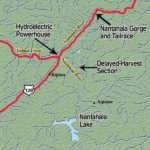
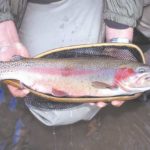
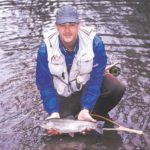
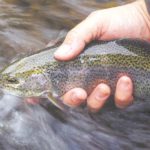
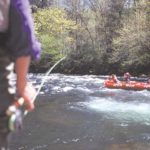


Be the first to comment